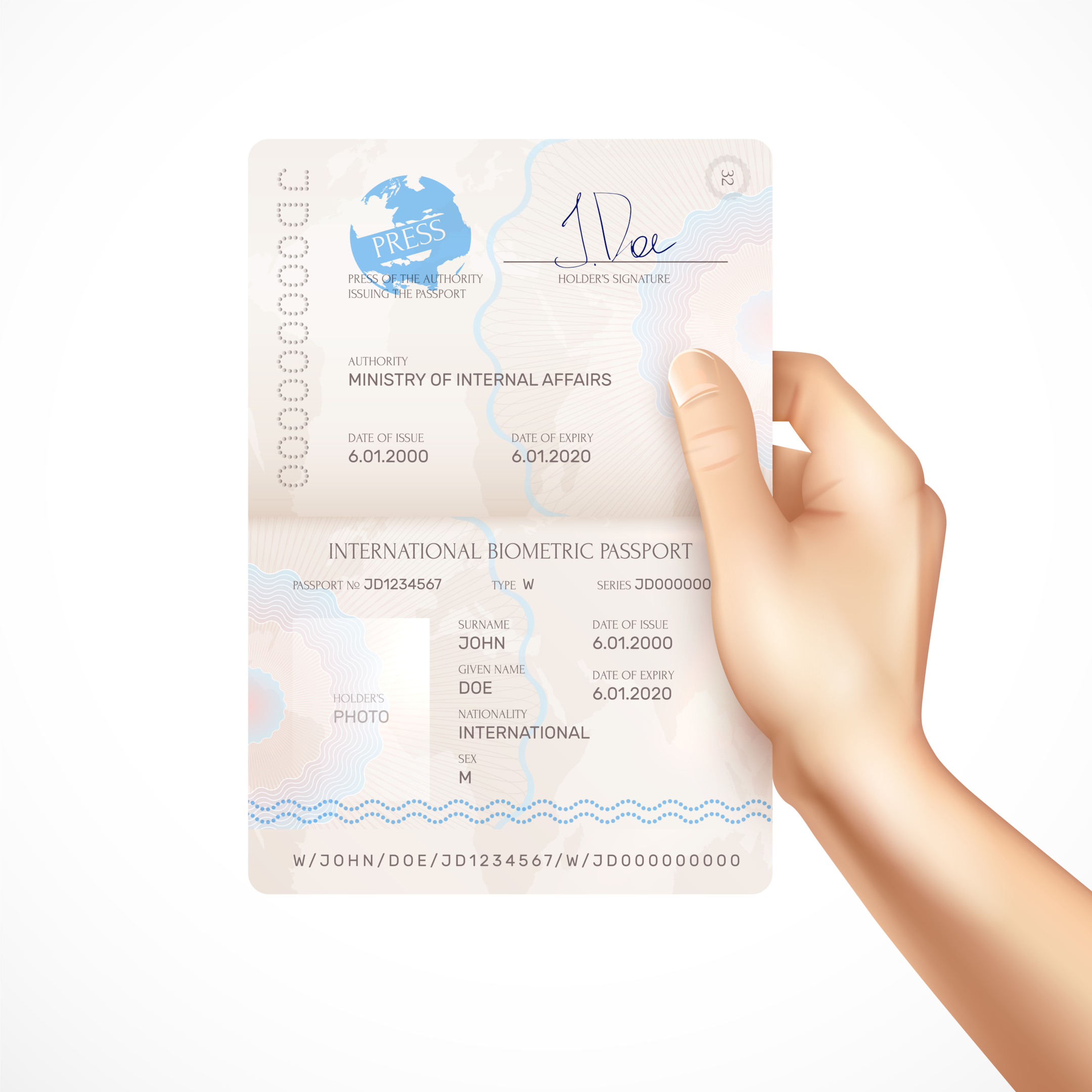As a powerful tool in identity verification, MRZ has become a staple in most passports and national identity documents worldwide. This specialized area on identity and travel documents, usually passports, encapsulates personal data in a format that machines can easily read and process.
Historically, the U.S. government emphasized the benefits of machine-readable information in 1983, marking the beginning of widespread MRZ adoption. Today, almost every country has embraced MRZ, encoding confidential information in two or three lines readable by Optical Character Recognition (OCR) technology.
This advancement in technology not only combats unauthorized alterations in IDs but also expedites the verification process significantly.
MRZ’s role in digital identity verification is undeniable. Its ability to provide detailed personal information in a standardized format greatly enhances recognition and verification processes. This includes accessing Radio-frequency identification (RFID) chips in biometric passports, which contain comprehensive information about the ID holder, offering a faster and more error-free verification method compared to manual processes.
What is an MRZ?
The Machine Readable Zone (MRZ) is a key component in modern ID documents, especially in passports and national identity cards. Essentially, MRZ is a dedicated area on these documents designed to be read by machines.
It typically consists of two or three lines of text that contain vital information about the document holder, encoded using Optical Character Recognition (OCR) technology.
This format allows machines to quickly and accurately read and process data such as the holder’s name, nationality, date of birth, and other personal details.
An excellent example of MRZ can be found in most international passports. The MRZ code on passport usually resides at the bottom of the identity page or the biographical data page. It contains all the important passport details, such as their full name, passport number, nationality, date of birth, sex, and passport expiration date.
This information is presented in a standardized format, making it easy for automated systems, such as border control checkpoints, to quickly verify the machine readable travel documents’ authenticity and the holder’s identity.
The incorporation of MRZ in ID documents marks a significant leap in security and efficiency for verification processes. Not only does it aid in preventing fraudulent activities by making alterations and forgeries more challenging, but it also significantly speeds up the process of identity checks.
Read more about passport verification and ID OCR.
What is the purpose of a machine readable zone?
MRZ on passports and other ID documents is an important step to prevent unauthorized changes and document forgery. It also speeds up the verification process.
MRZ holds the personal information of the holder in a universal format. This converts all the letters around the world into plain machine-readable text, allowing software and hardware to read it.
The machine-readable zone enables retrieval of information from a Radio-frequency identification (RFID) embedded within a biometric passport. This contains detailed information about the ID holder. When compared to the manual way, this process is several times faster. Additionally, the chance of errors is also significantly low.
How is data extracted from an MRZ code?
The Machine Readable Zone (MRZ) is a fundamental component of various ID documents worldwide. Understanding how data is extracted from it reveals the intricacies of modern identity data verification processes. Machines can read the MRZ codes by following these three steps:
Step 1: Capture and scan the MRZ
The MRZ consists of two or three lines of text with letters, numbers, and symbols, formatted in a standardized way to be easily read by the machines. Specialized devices like optical scanners powered by OCR software scan the identity document and capture the image of the MRZ.
Step 2: Data extraction
Once the MRZ is captured, the embedded text is recognized and extracted using OCR systems. The extracted text is then formatted in a structured manner. The information extracted from the MRZ is as follows:
- Holder’s Name
- Document number
- Date of birth
- Nationality
- Expiry date
- Security features such as check digits
Step 3: Data verification
The data verification process involves calculating the checksum of the extracted data and comparing it with the original checksums to verify the data’s authenticity. Visual inspection can also be done to cross-verify the data extracted from MRZ. If any mismatch is detected, then the document is labeled as suspicious.
Related Reads:
- What is Intelligent Document Processing (IDP)
- Optical Character Recognition (OCR) vs Intelligent Character Recognition (ICR): What’s the Difference?
MRZ in different documents and countries
MRZs are not limited to passports but are found in various identity documents across the globe. For instance:
- Passports: In Finland, the MRZ on passport starts with ‘P’ for the passport, followed by the issuing authority code and the document holder’s full name. The second line includes the document number, nationality code, date of birth, sex, date of expiry, and personal number. MRZs in passports often contain check digits for each data set, which help in fraud detection. Additionally, biometric passports and other electronic documents use MRZs to provide access to RFID chips for further NFC-based verification.
- Other Documents: MRZs are also found in vehicle registration certificates in countries like Poland and Bulgaria, work permits in Macau, and voter cards in Mexico and Mozambique. Their usage goes beyond travel and identity documents, showcasing their versatility in different applications.
- Innovative Applications: Some countries have added unique security features to their machine-readable documents. For example, German passports feature dual MRZs visible as lines and as a kinegram, while Israeli passports have an MRZ with a luminescent code visible under UV light.
Types of MRZ: Understanding MRZ lines
The Machine Readable Zone (MRZ), standardized under ICAO Document 9303, is a crucial aspect of identity documents. The MRZ facilitates quick and secure data reading and verification, which is vital in identity checks.
There are primarily three types of MRZs, each catering to different document sizes and requirements:
- Type 1 MRZ: Found typically on ID cards, this type comprises three lines with 30 characters each. It’s designed for smaller documents, such as national identity cards.
- Type 2 MRZ: This type is less common and consists of two lines, each containing 36 characters. Its rarity is partly due to its specific use case, which is less widespread than other MRZ types.
- Type 3 MRZ: The most commonly used type, especially in passports, Type 3 MRZ codes include two lines, each accommodating 44 characters. This format is standard for passport booklets, providing ample space for encoding all necessary personal details of the document holder.

The International Civil Aviation Organization standards ensure that these MRZ code types are universally recognized and readable by machines equipped with OCR technology.
The MRZ’s format allows the specification of basic personal details such as document type, holder’s name, document number, nationality, birth date, sex, and document expiration date.
It’s designed to maximize efficiency in document processing while maintaining high security and accuracy standards in identity verification.
For example, in a Finnish passport, the first line of the machine readable passport starts with a ‘P’ to denote a passport, followed by the personal number data, issuing authority’s code, and the document holder’s full name.
The second line contains the document number, nationality, country code, date of birth, sex, expiry date, and personal number. Check digits follow almost each data set to ensure data integrity and help detect fraud.
Importance and use cases of MRZ
The Machine Readable Zone (MRZ) plays a critical role in various sectors, enhancing security, efficiency, and reliability in identity verification processes. Here we explore its significance in different use cases:
Identity documents verification
MRZ significantly accelerates ID verification at border checkpoints, law enforcement offices, and in travel-related contexts such as airport and hotel check-ins. The rapid reading and processing of machine-readable lines data ensure quick and accurate identification, which is essential in high-security settings.
This streamlined identity verification process is critical for maintaining security while facilitating smooth operations in busy environments like airports and border crossings.
Read more: Explore our complete guide to document verification.
Age verification
In contexts like casinos, age verification is crucial. MRZ assists in accurately determining age based on the data encoded in identity documents. This application is particularly valuable in preventing underage access to age-restricted venues and services, thereby complying with legal regulations and maintaining responsible business practices.
Customer onboarding
MRZ is invaluable in customer onboarding for various businesses. It simplifies the data entry process, reducing the potential for human error and speeding up the customer onboarding experience.
This application of MRZ is especially beneficial in the financial sector, crypto, and other industries where customer experience and data accuracy are paramount.
Read more: Your Complete Guide to Onboarding Customers Safely with Digital Identity Verification
Know Your Customer (KYC) automation
MRZ plays a crucial role in automating KYC and AML processes in banking and financial institutions. MRZ enables these institutions to comply with regulatory requirements efficiently by providing quick access to accurate customer data.
This automation not only enhances customer experience but also significantly reduces the workload and time required for manual data entry and verification.
Fraud prevention
MRZ is a powerful tool in fraud prevention. By verifying the authenticity of documents through MRZ checksums and encoded data, it’s possible to detect and mitigate fraudulent activities at an early stage.
This aspect of document code is particularly crucial in sectors where document legitimacy is paramount, such as government services, financial institutions, and online platforms.
Read more about OCR automation.
MRZ and identity document verification
The Machine Readable Zone (MRZ) is a vital component in identity verification across various sectors. Its role in authenticating identity documents like passports, ID cards, and visas is paramount, making it a core security feature in these documents.
- Accelerating Verification Processes: Initially, MRZ’s primary function was to speed up the document-checking process at borders and airports. Encoding personal information in a machine-readable format allows for swift and accurate verification, which is essential in high-traffic areas like international borders.
- Universal Format for Identity Verification: The essence of MRZ lies in its ability to provide a universal format for identity data. It translates various world alphabets into a standardized Latin machine-readable text, ensuring consistent and reliable identity verification across different systems and territories. This universality is crucial in preventing unauthorized access and maintaining security in sensitive areas.
- Business Applications: Beyond its traditional use in travel and border security, MRZ has become an integral part of identity verification in visual inspection zones in business settings. Its implementation in corporate processes, particularly where identity verification is crucial, signifies its expanding role in various industries. The machine readable zones facilitate easy and reliable verification, enhancing security and operational efficiency in business environments.
Read more: Buyer’s Guide to Choosing the Best OCR software
Conclusion
In conclusion, the Machine Readable Zone (MRZ) is a critical component in identity verification, enhancing security, efficiency, and reliability across various sectors. Its ability to encode and provide universal access to personal data plays a pivotal role in streamlining verification processes.
Whether at international borders, in business operations, or in age verification, MRZ proves its significance by ensuring quick and accurate identity checks.
HyperVerge provides an end-to-end customer onboarding and verification stack for businesses globally. Explore HyperVerge’s identity verification solution and OCR software now.

 US
US
 IN
IN







